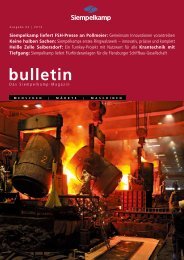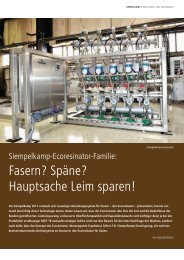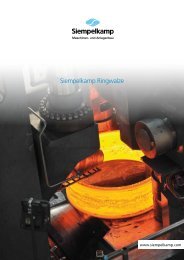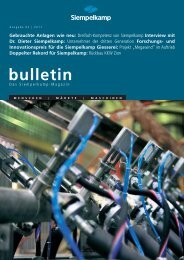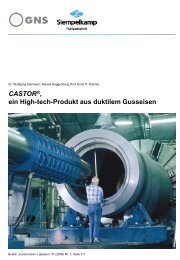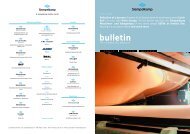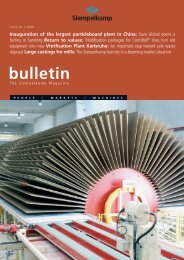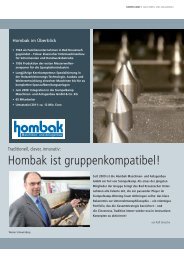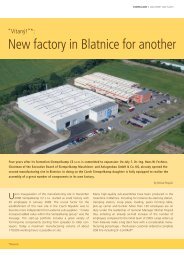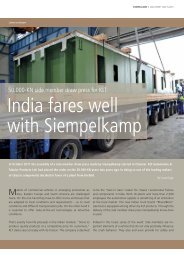Bulletin 1/2008 - Siempelkamp
Bulletin 1/2008 - Siempelkamp
Bulletin 1/2008 - Siempelkamp
You also want an ePaper? Increase the reach of your titles
YUMPU automatically turns print PDFs into web optimized ePapers that Google loves.
SIEMPELKAMP | MASCHINEN- UND ANLAGENBAU 32 | 33<br />
<strong>Siempelkamp</strong> supplied the press, within a complete press line<br />
from SMS-Meer, which was ordered in 2005, to Baoshan Iron &<br />
Steel Co. Ltd. Shanghai. It produced its first 40-inch pipe on<br />
January 31, <strong>2008</strong> (length: 12.2 m/40 ft, wall thickness: 21 mm).<br />
The 8 main cylinders, which were cast, assembled, and tested in<br />
Krefeld, have a weight of 107 t (118 US tons) each and a press<br />
capacity of 72,000 t (79,366 US tons). The press forms sheets with<br />
a length up to 18 m (59 ft) and a thickness up to 40 mm.<br />
The forming takes place using the CUO process: during the<br />
initial forming, also called crimping, the prepared plate is bent in a<br />
longitudinal direction. Next, the plate is transported via a roller<br />
conveyor to the U-press. A plunger is placed in the center of the<br />
plate in the U-press. Under the pressure of the plunger, the entire<br />
plate takes on a U-shape. With the help of two side rollers, the<br />
plate is then bent around the plunger into a long channel. After<br />
the U-forming process, the plate, now shaped like a U, is transported<br />
to the O-press. This so called “U-canning” is formed into a<br />
pipe in the O-press. An upper and a lower half-shell-shaped tool<br />
receive the U-canning and form the pipe.<br />
The finished pipes have a diameter of up to 1.42 m (4.6 ft). The<br />
press can process up to 500,000 t (551,155 US tons) of steel plates<br />
per year. Assuming that the heaviest produced pipe has a weight<br />
of 25 t (28 US tons), the production for one year would amount to<br />
a pipeline length of 360 km (224 miles).<br />
Made in Krefeld – supervised by <strong>Siempelkamp</strong><br />
The press was manufactured according to <strong>Siempelkamp</strong> construction<br />
plans made in Krefeld. Numerous important parts for the press<br />
were supplied directly by <strong>Siempelkamp</strong>. All elements concerning<br />
the drive system, the complete cylinders, the entire hydraulic and<br />
electrical systems and all the bearings are part of the <strong>Siempelkamp</strong><br />
scope of supply. The local content from China primarily included<br />
heavy parts such as the frames and press tables. These parts were<br />
produced in China according to <strong>Siempelkamp</strong> drawings and under<br />
<strong>Siempelkamp</strong> supervision. All press parts manufactured in Krefeld<br />
amount to a total of 1,500 t (1,653 US tons) compared to 2,800 t<br />
(3,086 US tons) for all parts produced in China.<br />
During the starting phase, the on-site assembly team included<br />
4 employees. This number was increased to 10 during the last<br />
quarter before production started. 3 supervisors and their teams<br />
were in charge of the mechanics, hydraulics, and the electrical<br />
system, and instructed the Chinese assembly personnel. The<br />
teams partly worked in two-shift operation in order to meet the<br />
individual deadlines. Some of these deadlines were met in record<br />
time, for example, the time between the beginning of the startup<br />
phase and achievement of limited functionality for the production<br />
of the first pipe was only two months. For older plants, it took<br />
twice as long to achieve this result.<br />
The first pipe<br />
The O-forming press<br />
Press cylinder control engineering – a quantum leap<br />
Broad competences and excellent references made Baosteel decide<br />
to go with <strong>Siempelkamp</strong>. <strong>Siempelkamp</strong> had already built, modernized,<br />
and successfully started up three of these large presses for pipe<br />
production. A highlight for the Chinese customer is the ongoing<br />
improvement of press technology. What seems so simple in writing<br />
is in reality a process involving enormous forces, which requires<br />
precision comparable to that of a clockmaker. Both material edges<br />
have to be precisely brought together by the forming process in<br />
order to achieve a precisely defined and preset weld seam.<br />
The deflection compensation of the crossbeam is one noteworthy<br />
feature of this pipe forming press. The deflection line of this 20 m<br />
(66 ft) long beam is measured via a sensor system and adjusted by<br />
means of a control system so that the deflection of the beam is<br />
kept to a minimum. In regards to control engineering, the press<br />
cylinder control system and the deflection compensation for the<br />
crossbeam in particular represent a true quantum leap.<br />
Another successful characteristic of the pipe forming press with<br />
the world’s largest press capacity is the improved hardware which<br />
results in reduced repairs and maintenance. This press is thoroughly<br />
robust and reliable. Our Chinese customer, who is already operating<br />
an open die forging press made by <strong>Siempelkamp</strong>, will produce<br />
pipeline pipes for the extraction of natural gas and oil. This way,<br />
China will achieve independence from other countries and can<br />
provide its own market with pipelines.



